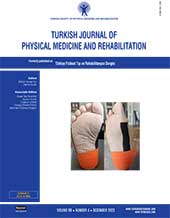Low-level laser therapy versus ultrasound therapy combined with home-based exercise in patients with subacromial impingement syndrome: A randomized-controlled trial
Patients and methods: Between March 2021 and July 2021, a total of 60 patients with SAIS (19 males, 41 females; mean age: 51.3±10.4 years; range, 30 to 70 years) were included. The patients were randomly allocated to an LLLT group (LG), an US therapy group (UG), and a control group (CG). The LLLT and US therapy programs were applied five times a week, for a total of 15 sessions. Home-based exercise programs and cold-pack therapy were administered to patients in each group. The patients were evaluated at baseline and one and three months of follow-up using the Visual Analog Scale (VAS) for pain during activity, at rest, and at night, and the Shoulder Pain and Disability Index (SPADI).
Results: All groups showed a significant improvement in the VAS and SPADI scores after the first month (p<0.05). The VAS activity pain score (p=0.008), SPADI pain score (p=0.003), SPADI disability score (p=0.012), and SPADI total score (p=0.003) significantly decreased in the LG compared to the CG at one month of follow-up. However, there were no significant differences in the outcome measures among the three groups at three months (p>0.05).
Conclusion: The LLLT combined with HBE is more effective than HBE program alone for relieving activity pain and improving shoulder functions in the short term. However, LLLT and US therapy do not provide additional effects in terms of pain and disability at three months.
Keywords : Exercise, laser therapy, pain, shoulder, therapeutic ultrasound

















